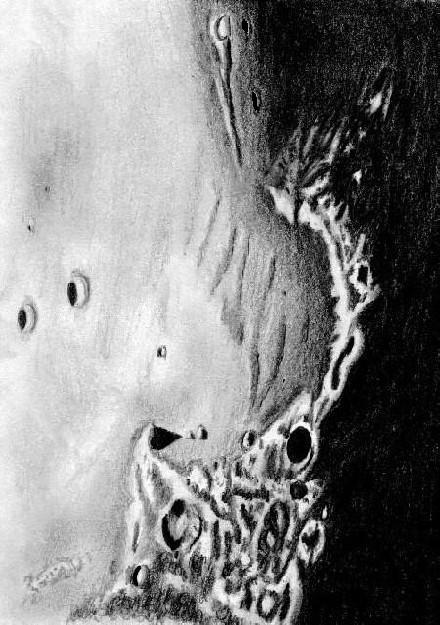
Sinus Iridum
Sketch and Details by Frank McCabe
Sinus Iridum (Bay of Rainbows) is one of the more attractive impact regions of the lunar moonscape under grazing illumination. The northern and western rim of this impact basin is composed of the rugged Jura mountain range from Cape LaPlace in the northeast to Cape Heraclides (the Moon Maiden) to the west. The bay reaches across a central distance of 260 kilometers. The entire southern portion of the crater rim is not seen for it is covered by the Mare Imbrium lava flows. First the massive impact that created Mare Imbrium about 3.8 billion years ago occurred. That event was followed by the smaller basin creating impact that left the large “crater Iridium” and subsequent events that buried its southern rim under lava flows some 3.3 billion years ago. Some geologists have suggested a seismic event before the lava flows aided in lowering the southern rim (see C.A Wood, The Modern Moon, p. 37).
One of the first sketches featuring Sinus Iridium in a telescopic view was done by Giovanni Cassini in 1679. In his drawing the Moon Maiden is featured. In my drawing Promontorium Heraclides (Moon Maiden) is seen at the upper right. Beyond this cape is a frozen wave of lava known as Dorsum Hein at the top center of the sketch. Following the arc of the sunlit Jura range, your eye arrives at the large shadowed floor of crater Bianchini (39km.) just beyond the half way point to Promontorium LaPlace (Cape LaPlace). Note the slumping of rim debris out into the bay from crater Bianchini. On to Cape LaPlace there is a tall mastiff at the cape that is casting a large triangular shadow that created a pleasing and eye catching view at the telescope ocular. Out beyond the reaches of the Bay of Rainbows are a pair of 20 km. diameter craters; Le Verrier is the slightly smaller one on the left and the other one is Helicon. This is a fascinating region of the moon to explore with a telescope and great fun to try and capture on paper.
Sketching
For this sketch I used: White CPP sketching paper, 9”x 12”, Numbers 2H, B and 4B graphite pencils, a blending stump, plastic eraser and an eraser shield. After scanning, Brightness was slightly decreased (-3) and contrast increased (+3) using Microsoft Office Picture Manager.
Telescope: 10 inch f/ 5.7 Dobsonian and 9mm eyepiece 161x
Date: 6-14-2008 1:30 – 2:42 UT
Temperature: 24° C (77° F)
clear, breezy
Seeing: Antoniadi IV
Co-longitude: 34.9°
Lunation: 10.26 days
Illumination: 81.5 %
Phase: 50.9°
Observing Location: +41°37′ +87° 47′
Frank McCabe
